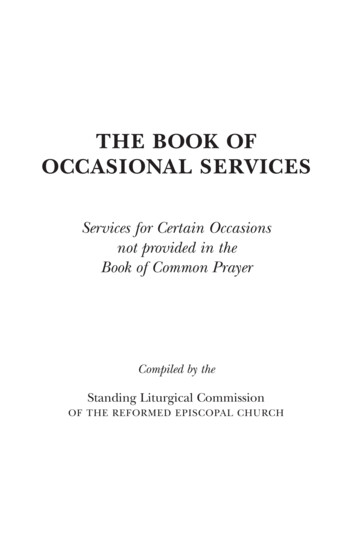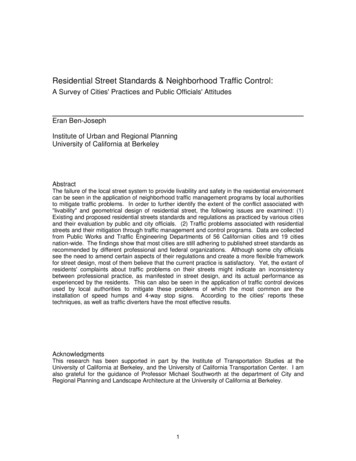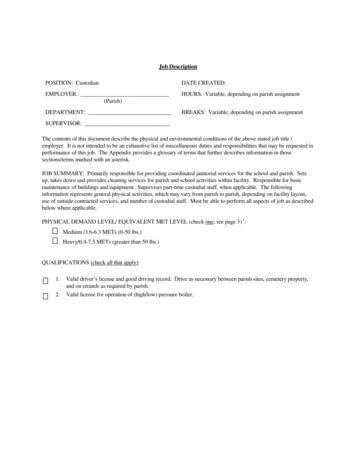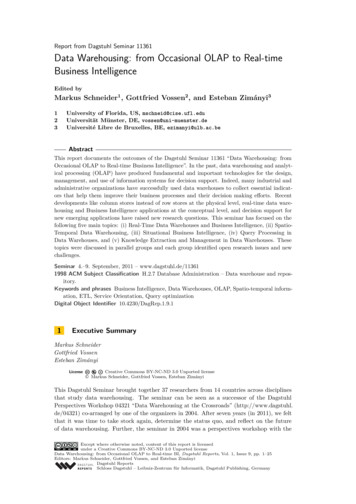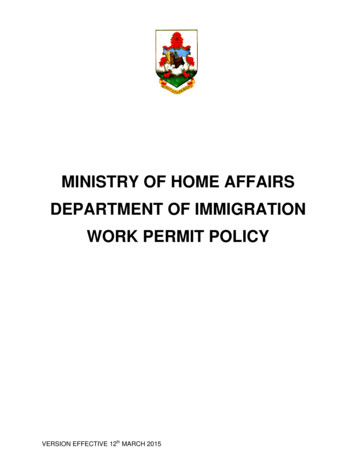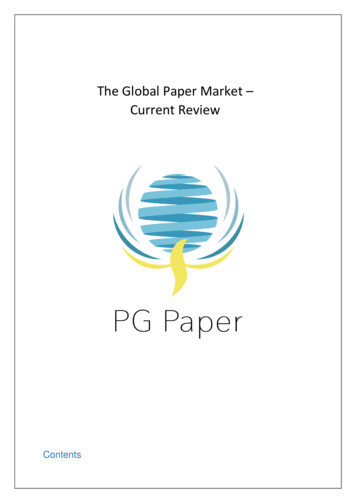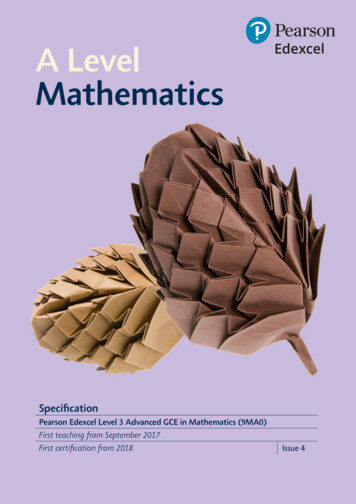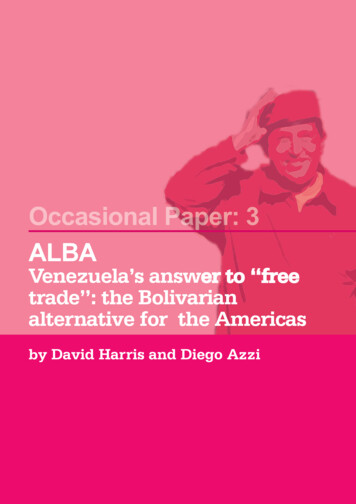
Transcription
Occasional Paper: 3ALBAVenezuela’s answer to “freetrade”: the Bolivarianalternative for the Americasby David Harris and Diego Azzi
The Occasional Paper SeriesThanksThe occasional papers are published by Focus onthe Global South. Although some of the authors areFocus staff or visiting researchers, we are open toproposals from individuals or organisations whowould like to submit papers for publication. The aimof the series is to publish new research and policyanalysis on key issues emerging from the processesof economic globalisation and militarisation and thecountervailing forces of resistance and alternatives.Without the support of our generous editors andinformants on four continents, the production of thispaper would not have been possible. Nicola Bullard,Mary Lou Malig, and Walden Bello at Focus on theGlobal South provided the initial instigation topursue the topic and gave helpful feedback throughout the writing process.The views expressed in this series are those of theauthors and do not necessarily represent the viewsof Focus on the Global South or the HemisphericalSocial Alliance.About the publishersFocus on the Global South is a non-profit policyanalysis, research and campaigning organisation,working in national, regional and internationalcoalitions and campaigns, and with social movements and grassroots organisations on key issuesconfronting the global south. Focus was founded in1995 and is attached to the Chulalongkorn UniversitySocial Research Institute (CUSRI) in Bangkok,Thailand.The Hemispherical Social Alliance (HSA) is anetwork of social movements and civil societyorganizations of the Americas’ joined in theirresistance to the free trade agreements in the regionand also dealing with hemispheric integration andsocial justice among our peoples. The initiative ofcivil society to create the HSA took place in 1997 andthe organization was formally created in April 1999.About the authorsDiego Azzi is a graduate student in Sociology at theUniversity of São Paulo, where he is currentlycompleting his master's thesis -- a study of changesin the political culture of activism. He graduated fromthe University of São Paulo in 2004.diegoazzi@yahoo.com.brDavid Evan Harris is currently completing hismaster's degree in Sociology at the University ofSão Paulo, with his thesis focusing on relationshipsbetween domestic workers and their employers inthe US and Brazil. He graduated from UC Berkeleyin 2003 with a bachelor's degree in PoliticalEconomy of Development. He is also the Director ofthe Global Lives Project ( outhFOCUS onGlobalAdditional thanks are owed to Alec Bamford,Gonzalo Berrón (Hemispheric Social Alliance),Maureen Santos (Brazilian Network for the Integration of Peoples - Rio de Janeiro), Maité Llanos(Continental Campaign Against the FTAA), GustavoCodas (Central Única dos Trabalhadores), EmmaSchwartz (Legal Times), Dorian Fougères (UCBerkeley), Jeff Woods, Lauren Baker (Center forInternational Environmental Law) and Flavio Lino (OGlobo).EditorsAlec Bamford and Nicola BullardContactsFocus on the Global SouthCUSRI, Chulalongkorn UniversityBangkok 10330 ThailandTel: 66 2 218 7363-65Fax: 66 2 255 9976Web: www.focusweb.orgHemispherical Social AllianceRua Formosa, 367 - 4to andarCEP 01049-000 São Paulo BrasilTel: 55 11 2104 0767/8Fax: 55 11 2104 0751Web: www.asc-hsa.orgALBA - Venezuela’s answer to “free trade”:the Bolivarian alternative for the AmericasOccasional Paper: 3São Paulo, Brazil - Bangkok, ThailandOctober 2006ISBN Number: 974-03-1792-8
ContentsAcronyms used2Summary3Untouchable Chávez5The Bolivarian AlternativeUnderstanding the Hemisphere: empire and empireExisting integration efforts in Latin AmericaALBA, the WTO and the G20Popular participation in ALBASocial Movements: important supportersConcrete proposals for institutionalizing ALBAALBA’s Future Prospects: breakdown by countries16Under Morales, Bolivia becomes ALBA’s newest memberCuba as ALBA co-founderBrazil’s ambiguous role in the regionBrazil’s complicated relations with USArgentina’s Kirchner key ALBA supporterMexican elections deepen regional divideRegional Developments23US “preoccupied” by PetroCaribe and PetroSurDifficulties seen in the formation of MercosurALBA: a model outside the Western Hemisphere?Conclusion26ALBA Timeline
ALBA Venezuela’s answer to “free trade”Acronyms usedALBA – Bolivarian Alternative for the AmericasCAFTA – Central American Free Trade AgreementCLOC – Latin American Coordinator of Rural OrganizationsCSN – South American Community of NationsFTA – Free Trade AgreementFTAA – Free Trade Agreement of the AmericasMERCOSUR – Southern Common Market
SummaryThe Bolivarian Alternative for the Americas (ALBA) represents the first attemptat regional integration that is not based primarily on trade liberalization but on anew vision of social welfare and equity. Alternatives are often either theoreticalto the point of impracticality, or so micro that scaling up presents huge challenges; ALBA is both large-scale and, to an increasing degree, taking concreteshape. While many aspects of the project are still unrealized or only in the process of realization, and despite some apparent contradictions between theoryand practice, ALBA is an important case study.The fact that ALBA is spearheaded by Presidents Chávez, Castro and, more recently, Morales, of Venezuela, Cuba and Bolivia respectively, the hemisphere’s3 biggest bogeymen for neoliberal imperialism, only makes the tale that muchmore interesting. When US President George Bush turns up in Latin America topromote the Free Trade Agreement of the Americas (FTAA), he is routinely coldshouldered; Chávez on ALBA is greeted like a rock star.Venezuela’s Answer to “Free Trade”: The Bolivarian Alternative for the Americas(ALBA), by David Harris and Diego Azzi, provides a detailed account, and a critical assessment, of the ALBA project to date.Work so far has involved an exchange of cheap Venezuelan oil for Cuban doctors and healthcare expertise. This includes ‘Operation Miracle’, which aims toprovide free eye operations, plus transportation and accommodation, to 600,000citizens of Latin America and the Caribbean each year. Bolivia’s recent entryin ALBA agreements saw it gain doctors and teachers, technical assistance formanaging its hydrocarbon extraction sector, and a market for its soy beans, whileits contribution is mainly in the form of its natural gas reserves.Harris and Azzi provide a summary historical background to the US economicand political hegemony over the region and compare the ALBA project with otherregional integration efforts, namely the South American Community of Nations(CSN), Mercosur, and the FTAA and bilateral Free trade Agreements between
ALBA Venezuela’s answer to “free trade”the US and various countries in the region. These otherefforts either directly support the neoliberal model that perpetuates US regional hegemony, or at best do not questionit. ALBA, by contrast, flies in the face of the WashingtonConsensus. The authors also point out that ALBA, unlikeother regional groupings, has so far played virtually no rolein international fora such as the WTO or G20.Working from the little documentation available, Harris andAzzi attempt to paint a picture of what the ALBA projectmay eventually look like. A handful of concrete proposalsare made explicit. These include participatory budgetingat the local level, revoking referenda and public declarations of income for all elected posts, public participation mechanisms, and a set of regional talking shops forelected office-holders. But the projected scope of ALBAis huge, covering 19 issue areas: 1. Oil and Energy; 2.Communication and Transportation; 3. Military; 4. External Debt; 5. Economy and Finance; 6. Light and Basic Industries; 7. Natural Resources; 8. Land, Food Sovereigntyand Land Reform; 9. Education; 10. University; 11. Scientific and Technological Development; 12. Mass Media;13. Health; 14. Gender; 15. Migrations-Identity; 16. Habitation; 17. Protagonist and Participatory Democracy; 18.Indigenous Movement; 19. Workers Movement. This is aclearly a much more comprehensive vision of internationalcooperation than your average trade agreement. Proposals for the realization of these areas of work run from aCooperative Bank of the South complete with credit card,to a regional TV and radio network, Telesur to continentaloil and gas pipelines.The authors point to a striking disjuncture between ALBAas it is visualized and ALBA as it has been practiced so far.The rhetoric is firmly grounded in popular participation andthe expectation that ALBA initiatives will ‘come from thepeople’. But most of what has happened has been put inplace by agreements signed by heads of government, withlittle sign of any involvement of the masses. The authorsspend some time tracking the initially wary but increasinglyfriendly attitude of social movements in the region.The paper provides a detailed scan of the position of eachof the major ALBA countries in turn, plus Brazil, Argentinaand Mexico. While Argentina and Brazil are beginning toget involved in ALBA activities, the prospects for Mexicoseem to have dimmed with the stealing of the presidentialelection from Andrés Manuel López Obrador. Brazil’s position is both important, as the largest economy in the regionand would-be UN Security Council permanent member,and seriously conflicted. On the one hand, the anti-poverty policies of the Lula government ought to dovetail easily into the ALBA framework. But the flagship state corporation Petrobras enjoys immense prestige at home whileoperating in neighbouring countries in a way that differslittle from other transnational oil companies. The paperalso gives a quick compare-and-contrast tour of regionalgroupings elsewhere in the world. The concluding section notes that while civil society inmany countries round the world is getting excited aboutALBA, the exercise also runs great risks. The authors concentrate on the threats within the major ALBA countries.But a quick word count reveals the dark shadow that loomsover the entire project: the main text contains 83 instancesof the words ‘Venezuela/Venezuelan’, 77 of ‘Bolivia-Bolivian’ and 49 of ‘Cuba/Cuban’. But ‘US’ occurs 74 times.And they don’t look like ever becoming a member.Focus on the Global SouthBangkok, ThailandHemispheric Social AllianceSão Paulo, BrazilOctober 2006
Untouchable ChávezVenezuelan President Hugo Chávez is untouchable. Untouchable in the sensethat despite the best efforts of a well-organized alliance created by some of hiscountry’s most powerful businessmen, major media networks and military officers, he has remained in power as a surprisingly popular and democraticallyelected president. But also untouchable in the sense that his Latin American andCaribbean neighbors are afraid to even get close to him politically for fear ofserious backlash from Washington. However, in this often-overlooked, yet veryvolatile corner of the world, major political shifts can happen almost overnight. Inthis case, it appears that Chávez may be able to very effectively ride the latestpolitical wave of anger at failed neoliberal economic policies, and the seriousideological vacuum that the situation has created, to push forward a major realignment of power relationships in the region.Take, for instance, the Summit of the Americas, held at the Argentine beach resort town of Mar del Plata in November 2005. The gathering drew world leadersfrom nearly every nation in the Western hemisphere, but not all evoked the samewelcome. US President George W. Bush arrived with hopes of jump-starting thestalled negotiations on the Free Trade Agreement of the Americas (FTAA). Instead, he was greeted not only by throngs of protesters and riots, but also by acold shoulder from most of the Latin American leaders whom he was hoping towin over. Contrast that to Chávez, who stole the show at the conference during Most notable amongst these efforts were the 2002 coup attempt and a 2004 call for anational plebiscite aimed at cutting off Chávez’ mandate mid-term. In December 2006,Chavez was re-elected with a landslide victory for a second six year term.Cuban President, Fidel Castro, has been excluded from all meetings of the Organization ofAmerican States (OAS) since the passage of a 1962 resolution excluding all adherents to“Marxism-Leninism” from the group’s activities. See “Resolutions Adopted at the EighthMeeting of Consultation of Ministers of Foreign Affairs, Punta del Este, Uruguay, January22 - 31, 1962.” The Avalon Project, Yale University, 1996. ntam17.htmThe FTAA is a proposed hemisphere-wide trade agreement similar in character to NAFTA, the 1994 North American Free Trade Agreement and CAFTA, the more recent CentralAmerican Free Trade Agreement. Though talks began in 1994 on the FTAA, the terms ofthe agreement have yet to be settled upon. All of the major summits held to discuss theagreement have been met by massive popular protests. For critical perspectives on theseagreements, see Public Citizen’s Global Trade Watch website: http://www.tradewatch.org .
ALBA Venezuela’s answer to “free trade”a two-hour speech he gave at the nearby football stadium,where he garnered a warm applause from both his presidential peers and an audience of 25,000 cheering activists. Indeed, Chávez’ image in the international community asthe sort of no-nonsense leader willing to speak his mindhad been cemented just a few months earlier at the 2005World Summit in New York. Chávez delivered an impassioned speech condemning American militarism and imperialism, and laid out a case for radical changes at theUnited Nations. The crowd roared with the loudest applause given to any of the 170 presidents, prime ministers,anddignitaries who spoke during the event. Chávez’ public support both inside and outside Venezuelais looking better than ever these days. His domestic opposition is in shambles after one too many desperate andfailed attempts to force Chávez from power or discredit hisgovernment. It also appears likely that Chávez will breezethrough another presidential race in 2006. By the end ofthe year, Latin America will have witnessed in the space oftwelve months a dozen presidential races and thirteen legislative elections. Budding alliances with leaders in Cuba,Bolivia, Argentina, Brazil, Uruguay, and potentially othernations in the coming months, make Chávez’ position lookever stronger. The region is ripe for all sorts of changes,and Chávez’ radical new ideas for Latin American integration on a cooperative, social democratic model—his “Bolivarian Revolution”—are certain to figure into the agenda.The BolivarianAlternativeWhile global “free trade” remains the mantra amongmany of the world’s most powerful nations, a handful ofLatin American leaders are developing a radical new setof ideas about the potentially liberating meanings of regional integration in the “developing” world. The BolivarianAlternative for the Americas (ALBA10) includes the promo 10 Elisabeth Bumiller, “Far Away From Home, No Rest for aWeary President,” New York Times, November 7, 2005, p. A6.Colum Lynch, “Chavez Stirs Things Up at the U.N.; Venezuelan Leader Wins Cheers With Rant Against U.S,” WashingtonPost, 2005, p. A14.John Vidal, “Hugo Chavez superstar; Even Brazil’s bourgeoisie love the World Social Forum,” The Guardian, February 3,2005. Juan Forero, “Chávez’s Grip Tightens as Rivals BoycottVote,” New York Times, December 5, 2005.Richard Gott, “Democracy under threat: Chávez will only gainfrom the US-backed opposition’s ploy to undermine elections,”The Guardian, December 6, 2005.Special note should be paid to Mexico, Brazil, Bolivia, and Nicaragua, key contests that will certainly shape both the region’sand Chavez’ future. See “Redrawing the political map; LatinAmerica,” The Economist, November 26, 2005.Perhaps more appropriately referred to as “deregulated international commerce.”ALBA, meaning “dawn” in Spanish, is the acronym fortion of trade between countries, and even the eliminationof tariff barriers on certain products, but its core purposegoes far beyond this. The explicit aim of ALBA is to promote the “social” side of development, eliminating povertyand combating social exclusion in a cooperative effort byLatin American nations.In late 2004, Chávez and Cuban President Fidel Castrosigned the first stage of ALBA. Its premise is based on avery simple notion: Cuba, a regional leader in medicine,would send Venezuela 15,000 doctors and assist in theconstruction of hundreds of new medical clinics in thecountry as well as with the training of Venezuelan doctorsboth on site and through scholarships to Cuban universities. In exchange, oil-rich Venezuela would provide Cubawith discounted petroleum imports with a value of USDone billion annually. The agreement did not stop there. Inan effort to attract other neighboring countries to this newstyle of international cooperation, Venezuela and Cubalaunched “Operation Miracle,” jointly offering free surgeryfor cataracts and other eye diseases to citizens of everynation in Latin America and the Caribbean. In 2005, Cuban doctors and hospitals performed more than 122,000surgeries and Venezuela provided free air transport andaccommodations to each of these patients.11 The governments aim to expand the program to serve 600,000 patients annually in coming years, performing operations inboth Cuba and Venezuela.12On April 29, 2006, Bolivia’s freshly elected President, EvoMorales—the first indigenous head of state in the nation’s180 year history—gave ALBA a big boost by traveling toHavana and signing a set of accords with Cuba and Venezuela making it the accord’s third full member. Venezuela and Cuba agreed to purchase Bolivia’s imperiled soycrop at “fair rates” as a US trade agreement with Colombiasigned in May threatened to fatally undercut Bolivia’s exports to its primary soy buyer.13 Groups of Cuban doctorsand teachers were assembled to aid Morales in his effortto remedy his nation’s chronic inability to provide basicsocial services to its desperately impoverished and dis-111213Alternativa Bolivariana para la America, named after SimónBolívar, a 19th century South American independence hero.This acronym plays on the Spanish acronym for the FTAA—ALCA.“Final Declaration from the First Cuba-Venezuela Meetingfor the Application of the ALBA,” April 30, 2005, publishedin English by Venezuelanalysis.com http://www.venezuelanalysis.com/articles.php?artno 1433. See also Gary Marx,“Chavez seeing to Cuba’s revival; Venezuela’s leader is bankrolling ocular surgery in Cuba for Latin America’s needy—andgiving his anti-US ally an economic shot in the arm,” ChicagoTribune, 2005.Tom Fawthrop, “Havana’s Operation Miracle helps eyepatients see light,” The Scotsman, November 26, 2005. Seealso, Pedro de la Hoz, “Chávez y Fidel sellan el Compromisode Sandino,” Diario Granma (Cuban Newspaper), August 21,2005.Agence-France Press, “Bolivia, Cuba, Venezuela Poised toSign Anti-US Trade Pact,” April 29, 2006.
enfranchised indigenous population. Thousands of scholarships were announced for Bolivian students to studyat both Cuban and Venezuelan institutions. While Cubatakes on the task of assisting Bolivia with increasing itsenergy-efficiency, Venezuela will provide extensive cooperation in restructuring Bolivia’s gas and mineral extractionindustries to the benefit of both countries, and to the likelydetriment of North American and European transnationalsthat have reaped many billions of dollars in profits fromthe country in recent decades. Bolivia’s contributions tothe alliance will come in the form of exports of natural gasalong with “mining, agricultural, agro-industrial, livestockand industrial products.” Tax breaks will also be providedon Venezuelan and Cuban investments in Bolivia, be theyeither state or mixed state-private ventures. Contributionsof knowledge on indigenous affairs and traditional medicine were also included in the laundry list of collaborativeefforts signed in Havana.14On May 1, 2006, International Worker’s Day, and just twodays after flying home to Bolivia from the ALBA signing,Morales made another major announcement—the nationalization of all hydrocarbon resources under Bolivian soil.15The details of each of these major turns for Bolivia andthe region remain to be seen, but everything indicates thatMorales is serious about using his strong electoral mandate to make serious changes for his country.Another key piece of the ALBA accord is TeleSUR, a panLatin American television network, which was up and running as of October 2005. Financed by the governments ofVenezuela, Argentina, Cuba, and Uruguay, and supportedin-kind by Brazil, TeleSUR aims to be the first televisionnetwork both by and for Latin America, a sort of Al-Jazeerafor the region.16 The network fills a gaping regionally-focused information vacuum; the only uniform programmingdistributed across Latin America comes from the privatelyowned, US-based networks CNN and Univision. Broadcasting in both Spanish and Portuguese, TeleSUR planseventually to host four different channels, providing content in news, culture, sport, and education for adults andchildren. While Chávez critics have questioned the legitimacy of a government-controlled media enterprise, thetruly impressive level of corruption found in the privatelyheld media in Venezuela (they were a key source of deliberate disinformation in Venezuela during the 2002 coup attempt) leaves no doubt that high-quality government pro-gramming could, at the very least, complement the free,private media already available in the region.17Future possibilities proposed for the ALBA union are numerous and imaginative. On the financial side, highlightsinclude a club of debtor nations, a region-wide development fund made up of 50% of would-have-been externaldebt payments and a Latin American version of the IMFdesigned to ensure regional currency stability. Cuba andVenezuela are already devising joint foreign aid projectsfor other countries in the region intended to eliminate illiteracy18 and improve health care programs and infrastructure. Generous new university scholarships will allow forgreatly increased educational exchanges in medicine andengineering as well as the humanities and social sciences.Argentina, known for having the region’s best cattle stock,is now shipping livestock to Venezuela in exchange for oildiscounts similar to those given to Cuba. Joint oil exploration and extraction projects between countries will also allow a larger portion of the profit from petroleum extractionto stay within the region.Projects such as these—and a great many more—are intended as steps towards achieving the dream of SimónBolívar, a 19th century Venezuelan independence herowho envisioned an independent and united federation ofSouth American states, much like the then-nascent UnitedStates to the north. But from colonial times to the present,a wide array of political forces has prevented such a unionfrom being realized. Even under the umbrella of Spanishcolonial rule, trade between individual colonies under thesame crown was forbidden.19 More recently, the UnitedStates’ focus on building supportive bi-lateral relations withfriendly nations (Peru, Colombia, Chile, Mexico), while atthe same time isolating others through economic, political,and even covert military means (Venezuela, Cuba, Bolivia), has hindered the development of closer ties within theregion.In their efforts to build popular support for the ALBA project, as well as for their domestic initiatives, Chávez, Castroand Morales all make regular and very effective referencesin their public discourse to the long history of dominationand control of their lands by foreign powers, thus embedding their own present struggles in a compelling narrative of resistance to colonialism and imperialism datingback more than 100 years. While the naming of the ALBA17141516“Agreement for the Application of the Bolivarian Alternative for the Peoples of our America and the Peoples’ TradeAgreements,” April 29, 2006. Published online by Governmentof Cuba. 0406i.htmlHarold Olmos, “Bolivian president aims to nationalize naturalgas industry, sends troops to fields,” Associated Press, May 2,2006.Kelly Hearn, “‘El’ Jazeera,” AlterNet, May 13, 2005. See also,Juan Forero, “And Now, the News in Latin America’s View,”New York Times, May 16, 2005, p. A9.1819John Dinges, “Soul Search: In Venezuela, the press strugglesto regain its bearings after serving as a tool of the anti-Chavezmovement”. Columbia Journalism Review, July/August2005, p. 53. On press freedom and independence, see also AlGiordano, “Welcome Telesur to the Struggle to Light Up theSkies.” Narco News Bulletin, July 24, 2005.Cuba’s literacy programs are widely known to be among theworld’s best; Cuban educators have also demonstrated significant sucesses in exporting their model to Venezuela since2003. See Humberto Márquez, “Venezuela Declares ItselfIlliteracy-Free,” Inter Press Service, October 28, 2005.Thomas Skidmore and Peter Smith, Modern Latin America,Oxford University Press, 2000, p. 356.
ALBA Venezuela’s answer to “free trade”agreement after Bolívar as well as Chávez’ 1999 re-naming of the Venezuelan state as the “Bolivarian Republic ofVenezuela,” are the most obvious examples of this, otherheroes are frequently referred to. The April 2005 declaration of the ALBA accord between Cuba and Venezuelaclosed with the following 1892 quotation from Cuban independence leader José Martí, “Our enemy obeys one plan:to inflame us, disperse us, divide us, suffocate us. That iswhy we are obeying another plan: to show ourselves inall our stature, to tighten up, join together, to evade him,finally making our homeland free. Plan against plan.”20 Morales, the youngest of the three ALBA presidents, calledthe April 2006 meeting in Havana “a historic gathering ofthree generations and three revolutions.”21Though ALBA is still far from a region-wide reality, bothpoliticians and civil society are increasingly heralding theproposal as a concrete alternative to the neoliberal modelfor globalization. As such, ALBA represents not just an attractive medley of innovative new programs and ideas forthe region, but also a strongly compelling and solid set ofprinciples through which neighboring states can take advantage of international partnerships and put them directlyto use for their people. Of course, it remains to be seenif the force of such an idea will catch hold either in LatinAmerica or elsewhere.Inasmuch as ALBA may appeal to certain parties, it willhave to overcome many obstacles. Regional rivalries anddomestic political pressures are sure to pose problems,but there is only one party with anything truly significantto lose from this realignment of priorities: the coterie ofneocolonial first world governments and multinational corporations that would like to continue to reap the benefits ofthe region’s resource wealth and economic dependency.22Directly and indirectly, they are also likely to mount considerable opposition.20“Final Declaration from the First Cuba-Venezuela Meeting forthe Application of the ALBA,” op. cit.21 BBC News, “Leftist trio seals Americas pact,” April 29, 2006.22For a particularly inflammatory example of such resistanceto Chávez delivered by way of Orwellian double-speak andimpressively inventive storytelling, see US Senate Majority Leader Bill Frist’s recent editorial in the Miami Herald,“Boycott of elections was right,” December 5, 2005. Frist,one of the most influential members of the Republican Party,is actively pushing for Chávez’ ouster on grounds of corruptelections, despite the fact that the most recent elections, alongwith the previous half-dozen, have been certified by teams ofinternational observers including the Carter Center (led byformer US President, Jimmy Carter) and the Organization ofAmerican States. For an informed rebuttal of Frist’s chargesabout Venezuela’s economy, see Mark Weisbrot, “Venezuela’sEconomic Performance,” NACLA Report on the Americas,September/October 2005, p. 52.Understanding theHemisphere:empire and empireIn 1823, as the Spanish Empire in Latin American crumbled, US President James Monroe declared, “the Americancontinents, by the free and independent condition whichthey have assumed and maintained, are henceforth not tobe considered as subject for colonization by any Europeanpowers.”23 This notion of “America for the Americans” sooncame to be known as the Monroe Doctrine, and provedto be one of the most important guiding principles of USforeign policy for the following century. Though its explicitgoal initially appeared as an effort to protect the newlygained independence of its southern neighbors, the Doctrine soon came to have a greater significance, identifyingLatin America as an inviolable piece of the US “sphere ofinfluence.”In 1904, US President Theodore Roosevelt modified thedoctrine to serve as a justification not just for defense ofthe hemisphere from European powers, but also to guideUS military interventions within countries in the region. Inan attempt to justify the US occupation of Cuba, the “taking” of Panama and the creation of a protectorate over theDominican Republic, Roosevelt wrote:“Any country whose people conduct themselves well cancount upon our hearty friendship. If a nation shows that itknows how to act with reasonable efficiency and decencyin social and political matters, if it keeps order and paysits obligations, it need fear no interference from the UnitedStates. Chronic wrong-doing, or an impotence which results in a general loosening of the ties of society, may inAmerica, as elsewhere, ultimately require intervention bysome civilized na
place by agreements signed by heads of government, with little sign of any involvement of the masses. The authors spend some time tracking the initially wary but increasingly friendly attitude of social movements in the region. The paper provides a detailed scan of the position of each of the major ALBA countries in turn, plus Brazil, Argentina

